Published
on 22
Sep 2021
|
All rights reserved.
|
|
|
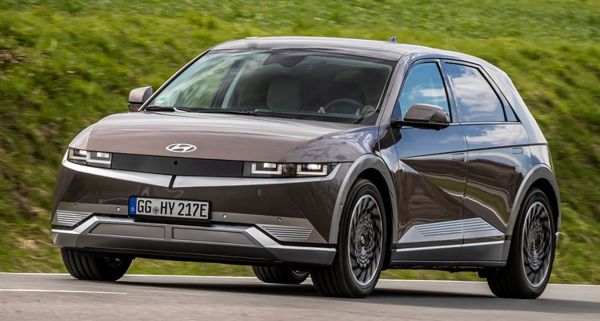
|
|
Probably
the most attractive and unusual EV since BMW i3.
|
|
While Volkswagen makes a
lot of noises about its EV offence, its ID range of cars and crossovers
are neither innovative nor very well executed. In fact, a little
disappointing, because they do not match the high standard of design
and build quality used to characterize the German brand. In contrast,
Hyundai group worked silently on its EV programs, but they turn out to
be the best yet we have seen among all mainstream car makers, Tesla
excluded. The first product from the Korean group is Ioniq 5, a very
stylish and well-made crossover.
The Ioniq 5 looks like a Golf-size hatchback, but it is actually a
mid-size car, which is evident in its 4635mm length, 1890mm width and
1605mm height. Hyundai’s designers successfully disguise its size with
huge, 20-inch wheels that are pushed to the corners, as well as a body
profile remarkably close to Lancia
Delta – although they insisted the car was inspired by Pony, the
first Hyundai small car that successfully entered the US market. The
influence from the Italian rallying classic is evident: not only the
silhouette but also the shape of the C-pillars and side windows, the
paper-folding surfacing and the straight crease line that runs across
its doors. However, unlike how Great Wall Motors copied Volkswagen
Beetle to make Punk Cat, the Ioniq 5 is not a copycat. While
inspiration comes from Lancia, the execution is original, and there are
tons of creativity shown in the details, such as a diagonal crease line
added to the side, the clamshell bonnet and pixelated LED head and tail
lights. These make the Ioniq 5 really stylish. Premium even.

|
|
Hyundai
said its styling is inspired by Pony. I say Lancia Delta.
|
|
Yes, the Ioniq 5 is set to be a premium product that an ID.4 or even
Audi Q4 E-tron can never accomplish. Priced between £37,000 and
£48,000 before incentives, it enters the heartland of BMW
3-Series, Mercedes C-class, Audi A4 etc. In the EV side, it competes
with Tesla Model 3, Polestar 2, Ford Mustang Mach-E and the
aforementioned German nameplates. Stiff competition. Is it good enough?
Judging from the interior, it is a winner. While the materials and
switch gears are not up to BMW standards, they can easily shame any
Volkswagen ID. The design is so fresh and trendy. There is an
MBUX-style panel that holds a 12.3-inch instrument display and an
infotainment touchscreen of the same size. The interface looks good and
responds quickly, plus there are some physical switches for air-con
etc. The environment is light and airy, with excellent visibility all
round.
Super-spacious, too. All occupants sit high in the cabin yet enjoy
generous headroom and vast of legroom, especially rear seat, thanks to
the incredible 3000mm wheelbase. The flat floor and the lack of
transmission tunnel also help freeing up legroom. Moreover, this cabin
offers plenty of features used to be reserved for MPVs, such as a
sliding rear seat that allows you to alter legroom and luggage space, a
center console that slides back and forth on rails, and front seats
that recline, fold and have calf support. In fact, the Ioniq 5 is as
tall as a Renault Scenic. You might just see it as an MPV disguised in
a much more attractive hatchback body. Why didn’t MPV makers think of
that?
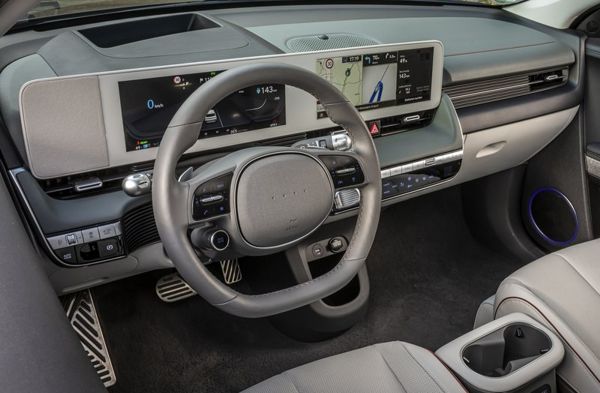
|
|
Interior
is stylish, super-spacious and offered with many MPV features.
|
|
At the back, the boot is quite high and shallow, as the motor is
working underneath, but it is wide and flat, offering 527 liters of
space. The tiny frunk is a joke, just big enough to store charging
cables and tools.
The Ioniq 5 as well as more upcoming Hyundai and Kia EVs are built on
the group’s first skateboard EV platform called E-GMP. All batteries
are placed under the floor and within the wheelbase. You can opt for
58kWh or 73kWh battery capacity, single-motor or twin-motor setup. The
single-motor drives the rear wheels, offering 170hp or 218hp depending
on battery size, and they sprint from 0-60 mph in 8 and 7 seconds,
respectively. Twin-motor offers 306hp and 4WD functionality, capable to
sprint from rest to 60 mph in 5 seconds, trailing only Tesla Model 3
and Polestar 2. For an EV without a performance badge, it is
remarkable. However, don’t forget a similarly-priced BMW M340i xDrive
manages 0-60 in 4.2 seconds and has a top speed 40 mph beyond the
electric Hyundai.
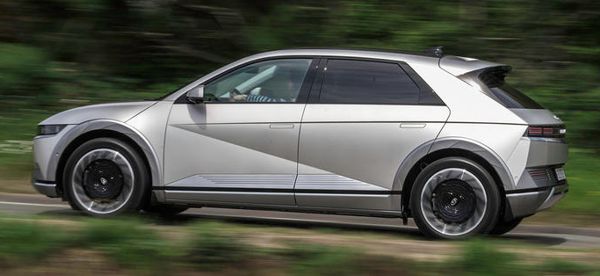
|
|
Suspension
is strongly oriented for comfort, failing to deliver tight body control.
|
|
Quick though it is, the Ioniq 5 is not designed to be hustled. If you
do so, you will find its soft, long-travel and comfort-oriented
suspension fails to contain its body roll in corner, pitch and dive in
acceleration and braking. The steering is light and muted. So the
Lancia Delta shape is only an illusion. Ride quality is generally good.
It does a good job to absorb potholes and low-speed bumps. However, as
speed rises, the car could feel floaty over undulations, lacking the
tight damping required for a composed ride. I know an Ioniq 5 N is
under making, but I think a decent body control and composed ride
should be the basic requirements for a premium car like this.
If you push the car, you will find the battery drain out in alarming
rate, just like any EVs. Drive more leisurely, however, the larger
battery might last 300 miles (481km) for single-motor or 267 miles
(430km) for twin-motor, pretty good. Charging performance is excellent,
as it supports 800V / 350kW charging stations, which beats even Porsche
Taycan’s 800V / 270kW capability. This means, recharge from 10 to 80
percent takes only 18 minutes, provided you can find such a charging
station.
The Ioniq 5 is an impressive effort from Korea. Extremely stylish and
tasteful, well made, incredibly spacious yet offers strong performance,
it has many things lo love. On the downside, the loose handling and
flawed ride quality rules out pure driving excitement, something Tesla,
Polestar, or even better, a conventional BMW 3-Series can easily excel.
Still, it is probably the most attractive and unusual EV since BMW i3.
|
Verdict:     |
Published on 7
Dec 2023
|
All rights reserved.
|
|
Ioniq 5 N
|
|
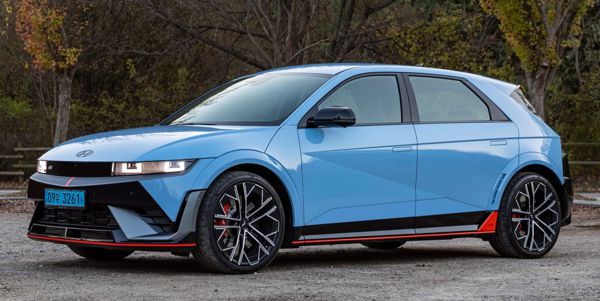
|
|
Hyundai's
N division proves that EVs can be great driver's cars.
|
|
Electric cars are boring,
but theoretically they can be made exciting to drive, because
everything can be tuned by software. First of all, if you are good at
acoustic engineering, you can simulate the noise of a V8, V10 or a V12
and play it through audio speakers. You may even place the subwoofer
under the bonnet and pump the sound through pipes into the cabin, just
to make them as real as possible. It all depends on how serious you
want to emulate the character of combustion cars.
Not happy with the on/off switch-like throttle response and flat torque
curve of electric motors? By reshaping the torque curve, you can get a
power delivery that encourages you to rev the motor like a good old
Honda VTEC. You may also program the motor output as if it works
through a dual-clutch gearbox, dropping revs after every gearchange,
hitting rev limiter after each downshift, with the torque changes
according to rev and gear. Too perfectly smooth? Add jolts to each
gearshift by momentary pause and engagement. Because silicon carbide
inverter is so powerful and comes with zero delay, you can simulate
whatever powertrain characteristics.
As for chassis, the freedom to control front and rear motors or even
all 4 wheels individually through power electronics create
unprecedented opportunities: variable torque split from 0:100 to 100:0
or anything in between, infinite torque vectoring between front wheels
and/or between rear wheels, drift mode, crab walk, playing donut or
even self-rotate.
I think many automotive engineers have envisioned these benefits long
ago. The question is, which manufacturer is serious enough to pour the
necessary budget to develop such an electric driver’s car. Porsche? BMW
M? Toyota Gazoo Racing? Surprisingly, it seems that Hyundai’s N
division arrives there first.
The N division has earned a strong reputation in recent years. It was
established by ex-BMW M boss Albert Biermann in 2014 (who has now
retired and acts as special advisor only) and strengthened further by
recruiting Tyrone Johnson as its vehicle development head in 2019.
Johnson’s CV included the last Ford Focus RS. He works at Hyundai
Europe’s R&D center in Russelsheim, Germany, explaining why the N
models are thoroughly tested in Nurburgring. Following i30 N, i20 N,
Veloster N, Elantra N and Kona N, the division’s latest and biggest
challenge is to make the electric Ioniq 5 as exciting to drive as its
ICE siblings.
The Ioniq 5 is a very good basis to start with. It looks pretty and
funky, with a strong resemblance to the classic Lancia Delta giving it
a psychological advantage when it has to fight against super hot
compact cars like Mercedes A45 S, BMW M2 and Audi RS3. Moreover, the
Ioniq 5 runs state of the art 800V electrical architecture and 350kW
charging rate, something Mercedes and BMW’s electric cars struggle to
match. This should make it easier to squeeze more power out of the
package.
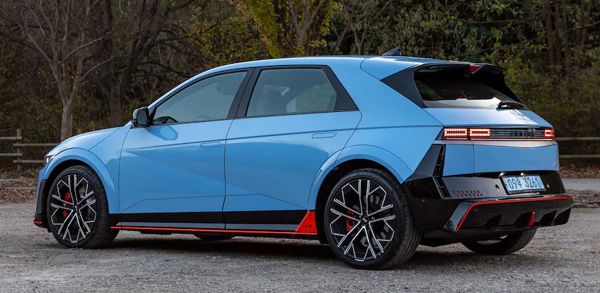
|
|
What
impresses most is how exciting it feels to drive. All the controls are
expertly tuned...
|
|
The Ioniq 5 N is derived from the dual-motor Ioniq 5, but it gets very
extensive modifications. The chassis is reinforced with extra spot
welds and adhesives, widened by 50mm and lowered by 20mm. Stronger
front and rear subframes are employed, as are stiffer mountings for
steering, motors and batteries. The steering ratio is tightened,
suspension is stiffened up, while massive (275/35ZR21) Pirelli P-Zero
rubbers are fitted, accompanied with monster-size brakes (400mm front
and
360mm rear), extra spoilers and skirts. Inside, there is a pair of new
bucket seats, an Alcantara steering wheel, some extra mode buttons and
aluminum pedals.
As for powertrain, the battery is enlarged from 77 to 84 kWh,
accompanied with upgraded inverter to enable higher output. Both motors
are new, spin faster (up to 21,000 rpm) and generate more power.
Combined output surges to 609 hp and 546 lbft, while overboost can take
it
further to 650 hp and 568 lbft for up to 10 seconds. An electronic LSD
is fitted to the rear motor, which is about 70
percent more powerful than the front motor to deliver a rear-biased
handling balance.
With so much power, the Ioniq 5 N is able to overcome its 2.2 tons kerb
weight and sprint from rest to 60 mph in 3.3 seconds. It will top out
at 162 mph, not the 115 mph limit of lesser Ioniq 5 models. Fast enough
to beat the aforementioned A45 S, M2 or RS3 from a stop light.
Admittedly, that is what we all expect from an electric hot hatch that
costs comparable money to the German premium cars, i.e. £65,000.
However, it is not all about straight line speed. Hyundai promises that
it has enough energy and cooling to lap Nurburgring under 8 minutes for
a couple of times, then take only 20 minutes charging to start it all
over again. Maybe not quite as enduring as petrol cars, but nonetheless
impressive for an electric performance car.
But what impresses most is how exciting it feels to drive. All the
controls are expertly tuned – the steering is feelsome and nicely
weighted; the brake pedal is responsive, suffering no dead feel as in
some EVs; the suspension is firm but controls the car's massive weight
pretty well. There is some more pitch and roll in sudden change of
direction than a usual hot hatch, but rarely hurt your confidence. With
torque split set to rear-biased, the car's turn-in is particularly
impressive, sharp and faithful. Turn off stability control and you can
induce some oversteer like a proper rear-drive performance sedan. The
great balance and adjustable manner remind us some of the best BMW M
cars in the past.
The N e-Shift mode does a good job to simulate the behaviour of an
8-speed DCT. You use the steering wheel pedals to trigger artificial
upshift and downshift, altering the torque and sound, hitting the
artificial limiter at 8000 rpm and even achieves engine braking with
it. So good that after a while you might forget that you are driving an
EV.
Less successful is the N Active Sound synthesizer, as none of the
3 soundtrack options sound real enough to please keen drivers.
Likewise, the N Drift mode is an unsuccessful attempt to replicate the
drift mode of AMG or BMW's all-wheel drive systems. It is just
impossible to hold the slide. More development work is needed. As it
is, the Ioniq 5 fails to play 4-wheel drift that its Group B rally
special looks suggested. In fact, being a much bigger and heavier car,
it is not exactly a hot hatch in the same sense of a Megane Trophy-R or
Civic Type R. Instead, it is a more matured high-performance car.
What makes the 5 N even more impressive is while it is fun to drive, it
keeps the easy-going manner and practicality of the standard car mostly
intact. A firmer ride and more tire noise aside, it is just as useable
as a daily driver as the regular Ioniq 5. The cabin is spacious and
well made. The hatchback versatility is kept. The charging from 10 to
80 percent takes just 18 minutes, and the range is still a respectable
250-280 miles (estimation).
Hyundai's N division has successfully created a great driver's car
based on an EV. While you might say Porsche did that first with Taycan,
the Ioniq 5 N is an even bolder attempt, just check the artificial
gearbox and variable torque split and you will see. At half the price
of the fast Taycans, the 5 N is also more relevant to most motorists.
Yes, £65,000 is a lot of money for a Hyundai, and I don't think
too many people will buy it instead of A45 S or M2, but it proves that
electric cars can be fun to drive. Sooner or later the same genes will
be passed on the company's smaller, cheaper electric hot hatches.
|
Verdict:     |
|